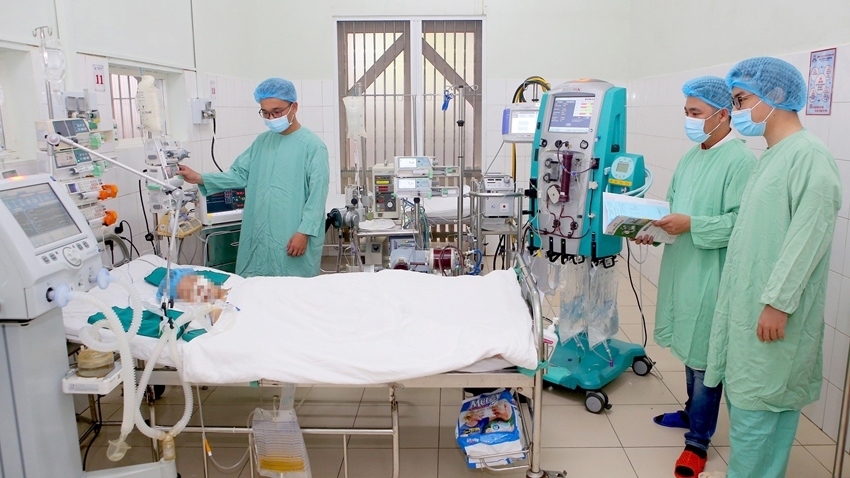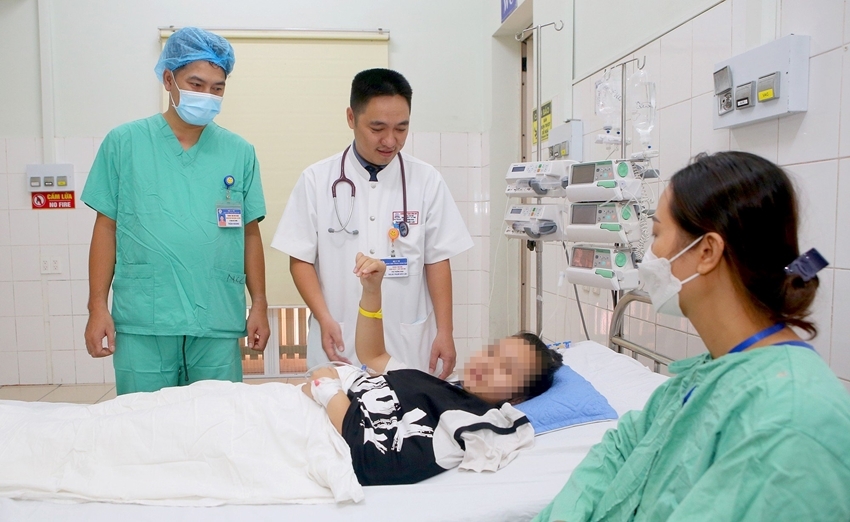    |
 |
| Conducting VA-ECMO technique combined with invasive mechanical ventilation to treat pediatric patient G.H. |
Previously, on the afternoon of May 30, 2023, pediatric patient Truong Phuc G. H. was taken to the Intensive Care Unit - Pediatric Emergency, Hue Central Hospital, having pain in the posterior sternum region, with electrocardiogram showing arrhythmia, ventricular, myocardial ischemia, laboratory test results indicated damaged myocardium. The patient was diagnosed with fulminant myocarditis, with a very high risk of death.
The patient received active medical treatment for fulminant myocarditis and closely monitored vital functions. After one day of treatment, the disease worsened, with ventricular fibrillation, decreased consciousness, and pulseless. Doctors performed cardiopulmonary resuscitation, electric shock twice, and intravenous antiarrhythmic drugs, but the ventricular arrhythmias persisted. The patient's condition continuously worsened with shock, hypotension, pulseless, anuria, and ejection fraction severely reduced to 32%.
Determining that this was a case of cardiogenic shock due to fulminant myocarditis with ventricular fibrillation, the risk of death was 100% if extracorporeal membrane oxygenation had not been indicated, specialists in the whole hospital came up with the most optimal solution.
After the consultation, the patient was immediately treated with veno-arterial extracorporeal membrane oxygenation (VA-ECMO) combined with invasive mechanical ventilation and active medical treatment.
    |
 |
| The patient is in full possession of senses, can eat porridge and drink milk |
After 6 days of treatment, the contractile function of the heart improved, the index reflecting myocardial damage decreased, the vital parameters and cardiac function improved, and the patient was discontinued VA-ECMO support and other machines.
Currently, the patient is in full possession of senses, in good contact, has pink lips, and can drink milk or eat porridge. Her pulse and blood pressure are stable, and she is no longer breathing oxygen and is about to be transferred out of ICU - Pediatric Emergency Department. The patient will continue to be monitored at the Department of Pediatric Cardiology and is expected to be discharged early next week.
Prof. Dr. Pham Nhu Hiep, Director of Hue Central Hospital, said: “The VA-ECMO technique was first successfully performed by doctors at Hue Central Hospital in Vietnam in March 2009, mainly in resuscitation for patients with myocarditis, cardiogenic shock after cardiovascular surgery. VA-ECMO is a cardio-pulmonary support technique that saves the lives of many critically ill patients who do not respond to conventional treatments; it helps the heart and lungs rest and gives time to recover.”
This is the first case of implementing the ECMO technique at the Pediatric Center, Hue Central Hospital, in collaboration with the team of ECMO experts, thereby improving the method of pediatric resuscitation and the professional capacity, majorly contributing to the quality of care and treatment of critically ill pediatric patients.
